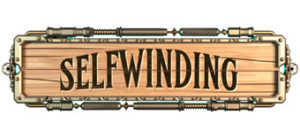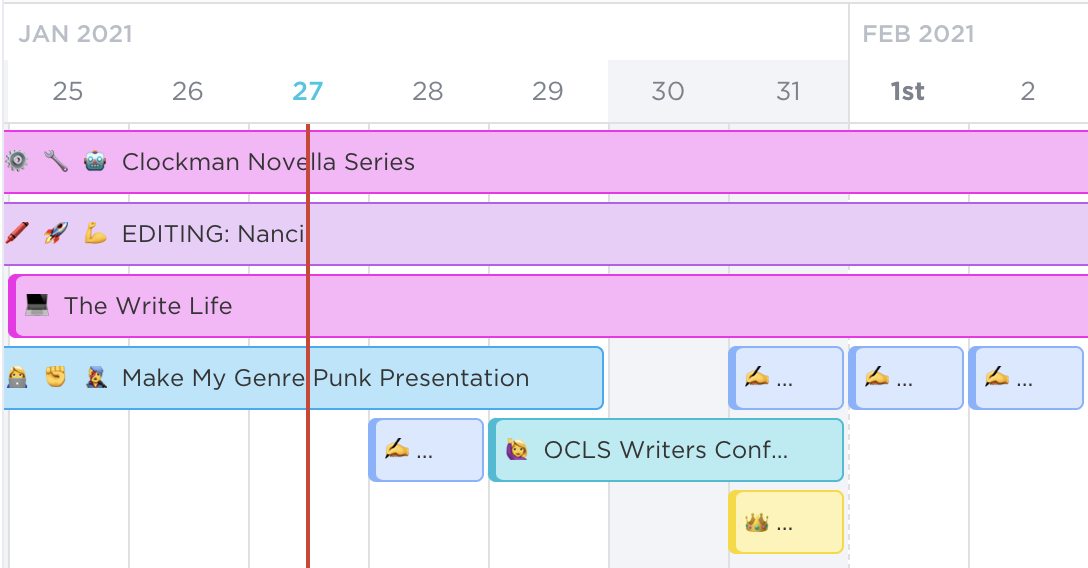 January was certainly a difficult month for finding focus, but somehow, I chipped through the distractions a little at a time to get myself organized for the next few months. Much of that organization came in the form of setting up a Click-Up workspace so I could lay all my various projects and schedules side-by-side to have a closer look at the overlap and impact of saying “yes” so many times.
January was certainly a difficult month for finding focus, but somehow, I chipped through the distractions a little at a time to get myself organized for the next few months. Much of that organization came in the form of setting up a Click-Up workspace so I could lay all my various projects and schedules side-by-side to have a closer look at the overlap and impact of saying “yes” so many times.
It’s been a lot of work to get organized—and I still have many projects that haven’t been fully mapped—but getting the majority of the next couple months captured in the same space is helping me feel more in control of my goals and obligations.
In general, I’ve been doing a lot more planning than I have in the past, including planning my writing projects. I talked last month about how I began breaking a steampunk novel into a three-part novella, which has required a lot of different stages of outlining and using multiple tools for organizing. I continued that planning work in January, applying some of the same organizational tools to smaller projects, which made setting up an outline for a short story a breeze—it also alerted me early on that the number of subplots I had dreamed up would put a heavier load on the story and I should either expect a longer word count or pull out the scissors.
(Some of those organizational tools I’ll be talking about in upcoming Writer Resources posts on Patreon, so if you’re planning a novel-length or series project and are cultivating ideas for tackling it, consider joining my Patreon at the $2 level to gain access to those posts and downloads of the tools I created for this process.)
The month hasn’t been all organization, though, because in addition to outlining and looking at project scopes, I also took the first steps toward the goal of writing 250,000 words this year. That word count is almost 20,000 words north of what I wrote last year, but when I listed all my projects and the probable word counts, it actually seems doable. Setting year-long writing goals can be a struggle in a normal year, but after the chaos of 2020, I think I’m ready to set a few:
- Write 250,000 words over the year.
- At least once a week write 1,000+ words in one day.
- Complete whatever monthly projects I set. (A little vague here since projects will change month to month, but I want to emphasis completing projects this year rather than just making progress on them.)
- And of course, write at least 250 words every day.
What writing goals are you setting for 2021?
For full access to The Write Life, sign up on Patreon for $1 or more per month. You’ll also receive a personalized thank you in a future edition of The Write Life.
Normally at this time of year I do an end-of-year assessment on the goals I set in January, or do some kind of wrap up to talk about what I achieved. But 2020 was so wildly unpredictable that most goals I set for myself quickly morphed, and I came to accept that writing things that made me happy was more important than anything else.
Even so, in this last month, I finally started a project I’ve been putting off all year.
The last time I re-submitted revisions on my agent pursuit, I came up with the wild idea to split my finished novel into a novella trilogy. I decided to wait through one last round for agents to respond, then a publisher’s open call, before dedicating myself to dividing the novel for self-publishing.
…And then I waited two more months because who wants to do all that extra work if you can just keep waiting???
But as I waited, I thought more about what the revision from novel to novella series would look like, and the more I thought about it, the more I wanted to do it (even if I kept procrastinating on making a mess out of something that was “done”).
 In December, I finally bit the bullet, split my Scrivener file, and started outlining each part as a separate novella. The original novel structure with three distinct acts means making the initial split was easy, but work still needs to be done to establish inciting incidents for each part and ensure each book resolves a major conflict. (Also, increasing the word count overall, or else I’ll have a short story and two short novellas.)
In December, I finally bit the bullet, split my Scrivener file, and started outlining each part as a separate novella. The original novel structure with three distinct acts means making the initial split was easy, but work still needs to be done to establish inciting incidents for each part and ensure each book resolves a major conflict. (Also, increasing the word count overall, or else I’ll have a short story and two short novellas.)
So far, the first novella is fully mapped out, and the existing parts from the other two have been structured so I have some idea of what’s missing. I still have some planning to go before I start writing, but I’m expecting these revisions (and prepping the series for self-publishing) to be my major project through most of 2021. I’ll be launching some new tiers and rewards on Patreon to support this project, so if you’re interested in reading more about the self-publishing process or seeing previews of the work-in-progress, keep an eye out for that announcement, likely in February or early March.
For full access to The Write Life, sign up on Patreon for $1 or more per month. You’ll also receive a personalized thank you in a future edition of The Write Life.
Any way I slice it, November is NaNoWriMo. This year I elected to save myself a little frustration, aggravation, and sanity, and decided to not write 50,000 words. 2020 has been enough of a mess without struggling to slap words on a page while feeling the stress of an arbitrary deadline (plus needing to fulfill my duties as a NaNoWriMo Municipal Liaison for Orlando, FL). Ultimately, I think this was the right decision, and it freed me up to enjoy more of the events I organized during the month. And the one I want to talk about is the biggest event I worked on: Write Around (Virtual) Disney World.
We’ve been running an in-person Write Around Disney World since 2013. We meet in a central location on Disney property and then use free Disney transportation to travel (by all means available) to various non-ticketed locations to write. Our path typically takes us to hotel lobbies and cafeterias, where tourists wonder why there are suddenly so many people sitting around with laptops and furrowed brows.
When the pandemic looked like it would keep our region at home this year, I began planning how to turn our biggest writing event into a virtual experience.
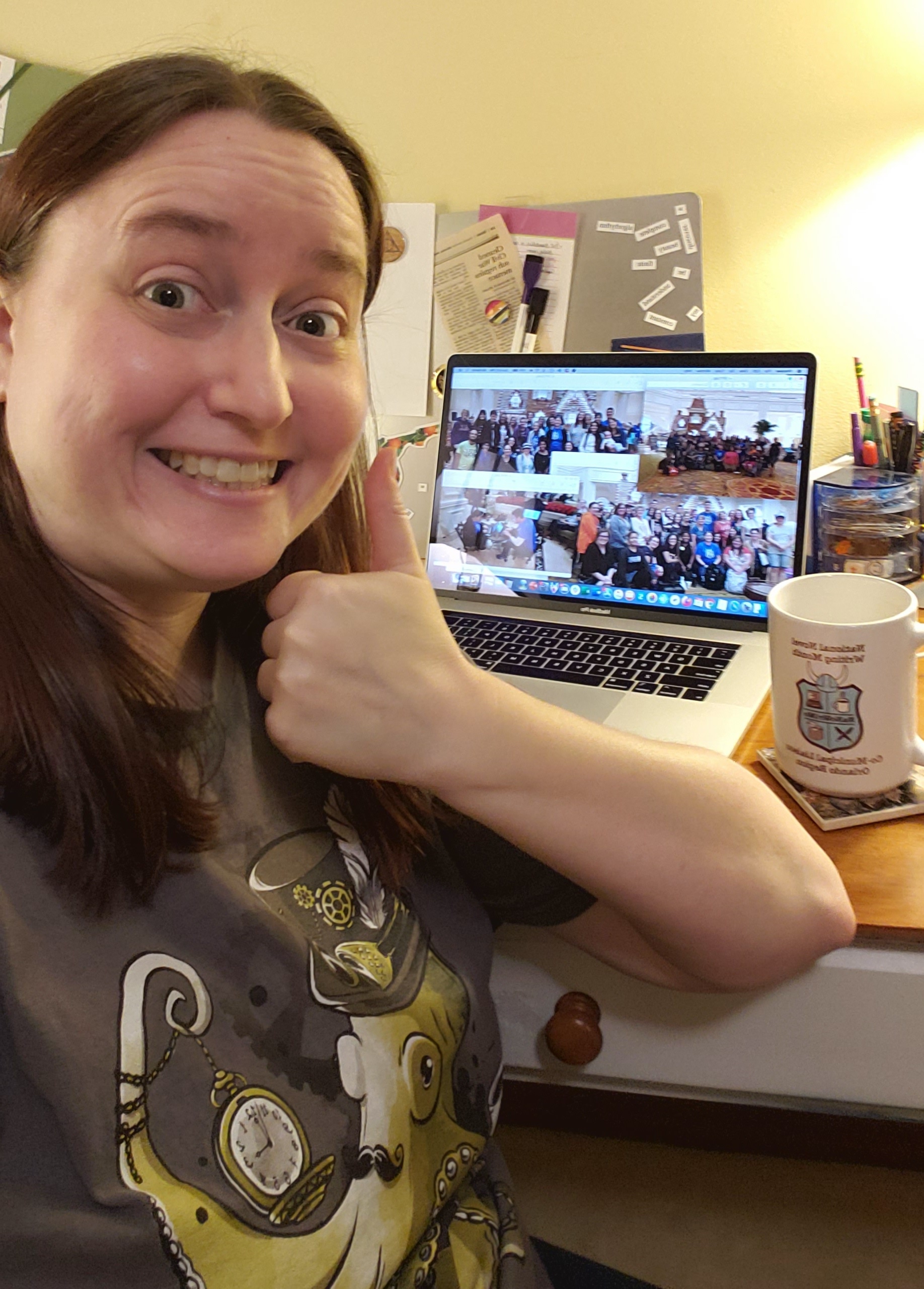 With the help of my friend, KL Cripe, we created a virtual traveling write-in hosted on three of our NaNOrlando social media platforms—Discord, Twitter, and Facebook. Since a virtual experience removed the need for a Disney ticket, we also took the opportunity to move our writing stops inside the Disney parks, visiting three inspiring locations in Animal Kingdom, Hollywood Studios (yes, we picked Galaxy’s Edge), and Magic Kingdom.
With the help of my friend, KL Cripe, we created a virtual traveling write-in hosted on three of our NaNOrlando social media platforms—Discord, Twitter, and Facebook. Since a virtual experience removed the need for a Disney ticket, we also took the opportunity to move our writing stops inside the Disney parks, visiting three inspiring locations in Animal Kingdom, Hollywood Studios (yes, we picked Galaxy’s Edge), and Magic Kingdom.
Each location included a welcome, description of the location, how the location could inspire a writer, and time in which to write. We posted pictures from previous years (or from independent visits, in the case of our special in-park locations) and links to ambience sounds or music to help writers feel like they were actually there. We also included transportation between each stop because traveling by boat, bus, and monorail is just part of the appeal of Write Around Disney World.
In the past we’ve escorted up to 70 writers at our in-person write-in, which was about the same turn out for our virtual event. And not everyone was from Orlando. We had writers joining us from California, Arizona, Wisconsin, Georgia, Virginia, Ohio, Vermont, and even Canada! I’m so glad we were able to successfully execute this event virtually. Every year we have writers who can’t join us, often because of transportation or mobility issues, and I’m excited to prove that we can bring this unique writing experience to everyone, despite the limitations that exist in the real world.
2020 has been an absolute mess, but I feel like it’s been a year to teach us about accessibility and I hope more event organizers are learning the same lesson I am—with a little creativity, we can shift our events so that anyone is able to participate.
If you want to check out Write Around (Virtual) Disney World, I recommend visiting our Twitter threads, organized by location:
For full access to The Write Life, sign up on Patreon for $1 or more per month. You’ll also receive a personalized thank you in a future edition of The Write Life.
October is always a busy month for me because it’s all about the NaNoWriMo Prep. As a Municipal Liaison for my local region, I spend less time prepping myself and my project, and more time prepping events and social media posts and coordinating with local writing groups. One of the biggest events I handle in October is the NaNOrlando Writers Conference.
This is the third year I’ve put on this conference with the help of the Orange County Library System and generous writers who have willingly let me bully them into donating their time and experience to teach wrimos about quick drafting, preparing their characters and world, and using conflict and inspiration to fuel their novel throughout the month. (I’m mostly kidding about the bullying. If you ask a writer to talk about writing, it’s harder to get them to stop talking.)
Since this year was a virtual event, I reached beyond our usual stable of local writers and drew in my friend Karen Osborne (whose awesome science fiction novel debuted in August) and Pitch Wars mentors Sofiya Pasternack and Emily Colin. I loved getting to have a few new ideas about writing conflict and approaching world building, and Emily tackled a topic on inspiration that has been on my wish list for a while. Joining our distanced instructors were Jenny Broom (Developing Your Main Character), Elle E. Ire & José Iriarte (Finishing Your First Draft), and Jennie Jarvis (Basic Plot Structures). With these six workshops we covered pretty much every basic element of storytelling and every trick to help writers get through a 50,000-word draft of a novel in a month.
I took a lot of notes throughout the conference, tweeting some of the best quotes and advice to our NaNOrlando Twitter account (some of which also appeared on our Facebook and Instagram), but I figure the best way for me to talk about the conference is to leave you with some of my favorite quotes. So, here’s what I learned or was reminded of during the 2020 NaNOrlando Writers Conference:
-
Considering why was a recurring theme in developing worlds and characters.
Sofiya suggested that every time we answer a question about the world, ask why to learn more about the underlying structure of the world.
Jenny also reminded us that the why of a character’s choices says a lot about the character. -
Karen compared story conflict to a three-lane highway, with the story-car weaving in and out of these lanes to switch between conflict with the self, conflict with others, and conflict with the environment. Considering that I always think of story threads as braiding, this description really appealed to me.
-
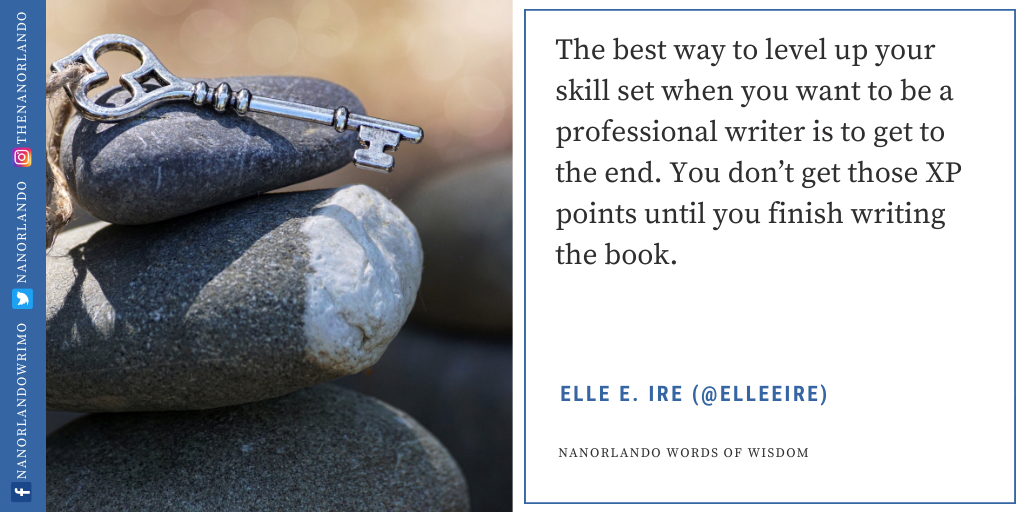 I’ve heard José and Elle talk about writer XP in other presentations, but I always love this quote from them, “You don’t get those points until you finish writing the book.” I think about this every time I leave a story half-finished, or when an outline stops without an ending. I have to keep going if I want to level up!
I’ve heard José and Elle talk about writer XP in other presentations, but I always love this quote from them, “You don’t get those points until you finish writing the book.” I think about this every time I leave a story half-finished, or when an outline stops without an ending. I have to keep going if I want to level up!
-
Emily reminded us to revisit what first excited us about our projects when we feel blocked or bored. José also noted that when he feels blocked, it means his subconscious knows what he planned doesn’t make sense. Both thoughts made me feel better about going back to planning in the middle of drafting—sometimes you have to go backward to go forward.
“Aristotle believed that the whole reason we engage in stories to begin with is because we’re able to experience something vicariously that we can’t experience in our own life.” — Jennie Jarvis
“We write to get into a story, so even if you don’t use it, it helped you get into the story.” — Jenny Broom
“Nano is a hot mess while it’s happening, but you get words on the page and you can turn it into awesome stuff.” — Sofiya Pasternack
“The things that make you feel bad about sitting down to write are the killers. Forgive yourself for what you did not do yesterday. Every day is a clean slate.” — José Iriarte
For full access to The Write Life, sign up on Patreon for $1 or more per month. You’ll also receive a personalized thank you in a future edition of The Write Life.
September was another long, weird month that seemed to drag so much more than the summer. (I’m still constantly thinking it’s the end of July or August.) But the slog of September also brought my usual escape from the stress and frustration of the year: DragonCon.
DragonCon was of course a virtual experience for 2020, and despite attending several successful virtual conventions earlier in the year, I was a little worried about what it would be like. Others have done the work experimenting with formats and troubleshooting technology, and attending social events virtually is now a well-rehearsed skillset, so I wasn’t concerned about them pulling off DragonCon. I was concerned about whether or not it would feel like DragonCon.
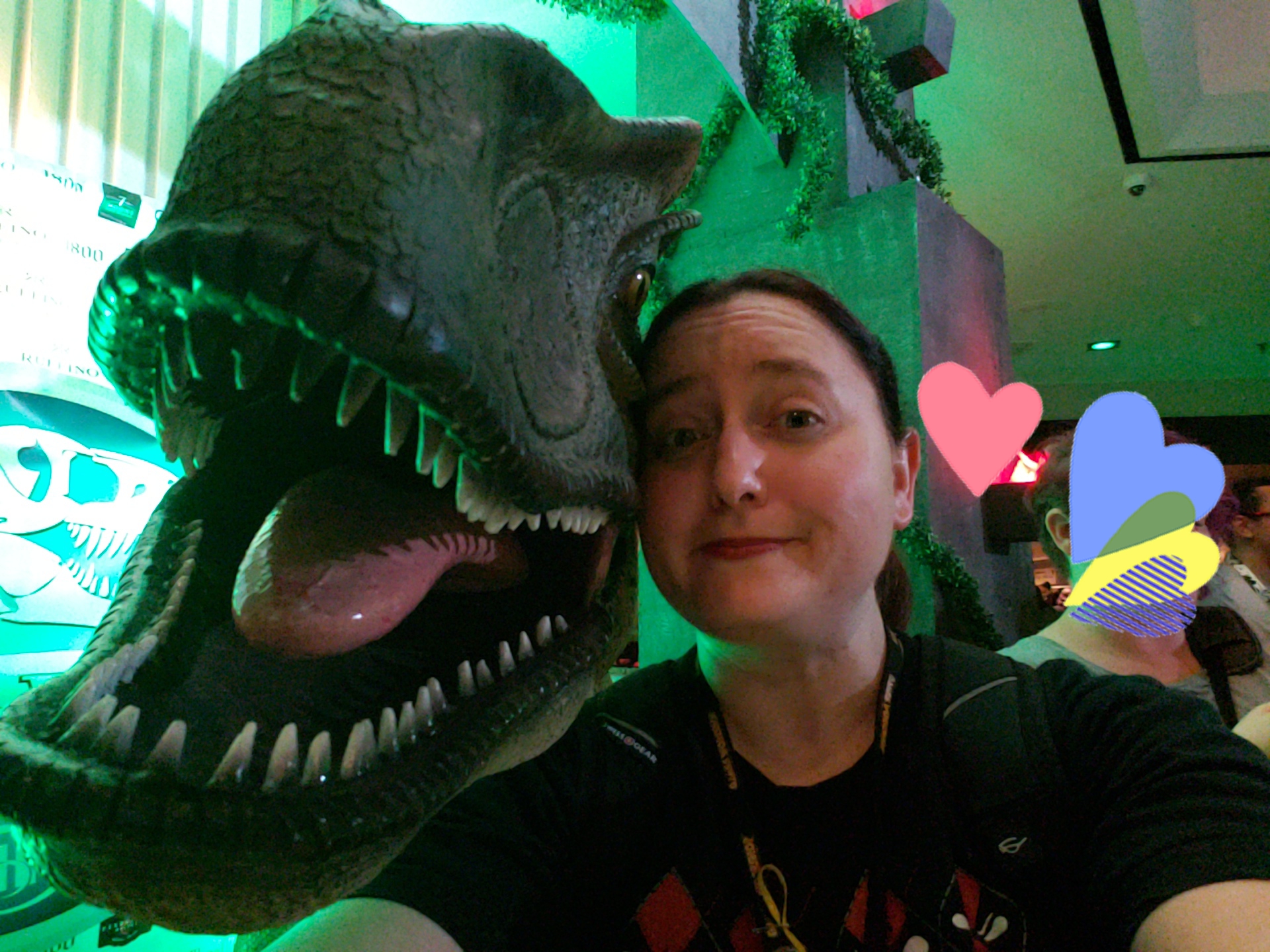 DragonCon is a special brand of weird. It’s wandering the lobbies of the Marriott and Hilton and freezing in place while a conga line of Deadpools circles. It’s hugging friends, celebrities, and strangers you’ve been queueing with for an hour. It’s admiring the growing shrine to FedEx Jon on the walkway to the food court and celebrating when you find an enamel pin of the Marriott carpet tucked inside a planter. It’s following up a season recap panel for your favorite show with one about queerness in Batman or how artificial intelligence in science fiction traces back to Frankenstein.
DragonCon is a special brand of weird. It’s wandering the lobbies of the Marriott and Hilton and freezing in place while a conga line of Deadpools circles. It’s hugging friends, celebrities, and strangers you’ve been queueing with for an hour. It’s admiring the growing shrine to FedEx Jon on the walkway to the food court and celebrating when you find an enamel pin of the Marriott carpet tucked inside a planter. It’s following up a season recap panel for your favorite show with one about queerness in Batman or how artificial intelligence in science fiction traces back to Frankenstein.
It is being surrounded by nerds celebrating being nerds in a thousand different ways.
And I was concerned it wouldn’t fully translate to an online format.
(I was also concerned about my waning tolerance for video meetings, but that’s a secondary issue.)
My friends and I banded together for group chats during live panels, met for the parade Saturday morning (a mix of submitted footage/photos and parade video from previous years), and even had “lunch” together for a final hurrah on Monday. We had spontaneous video chats with whomever was available, catching up on what panels we went to and which ones were worth watching later (virtual convention means you can rewatch some of the content!), and we introduced each other to new shows and memes. We talked until bedtime every night and were frequently the first people we communicated with in the morning—not unlike con at all.
I watched panels about steampunk, Victorian death customs, and the pyramids of Giza. I moderated a season recap panel about The Umbrella Academy. I watched Q&As with present and past guests like John Romita Jr., Richard Dean Anderson, and Carrie Fisher. I stumbled into unexpectedly hilarious panels like Bar’d Talk, which was a combination of Whose Line and Shakespeare. I shared stories and photos from past DragonCons with my friends (I’ve been going since 2003, I have a lot to share). And I got to step away from the stress of 2020 for a weekend and just… breathe.
Maybe I had to work a little harder this year to feel immersed in DragonCon—I certainly exercised my imagination every time my friends and I joked about saving each other seats in panels or going to the food court when breaking for lunch—but I still got to celebrate being a nerd with other nerds. When it comes to DragonCon, that’s all I really need.
(Well, that and the name of that Peter B. Parker cosplayer from 2019. I really should have proposed marriage.)
For full access to The Write Life, sign up on Patreon for $1 or more per month. You’ll also receive a personalized thank you in a future edition of The Write Life.
This past month I hit a wall in my work-in-progress. I really struggled revising the end of a chapter and making it feel ~complete. What I wrote was fine, but it wasn’t really good, and it didn’t do the things a chapter end should do (specifically both wrap up and carry forward). And the whole frustrating experience made me think a lot about when writers should ask for help and what kind of help they should seek.
In general, my advice for writers is that they take a story as far as they can independently before asking for outside feedback and assistance. What that means will vary writer to writer and project to project. Sometimes that might be the end of a second draft, and other times the end of a fourth or fifth draft. Or sometimes it might be the end of one specific chapter that is driving you to drink and perhaps you just desperately need someone who can see the forest instead of every damn tree!
Ahem.
The kind of feedback a writer seeks depends on what they are prepared to do with the story after receiving feedback. Sometimes, like in my chapter, I need someone who can be a genius and help me pinpoint what’s wrong. That’s when I need focused feedback that will lead to a revision. Other times I really am just looking for positive reinforcement. For someone not just to tell me something doesn’t suck, but to say that it’s good (maybe even great).
The latter type of feedback is performed by Cheerleaders, and the former we’ll classify as the work of Problem-Solvers.
Cheerleaders usually come from your friends and family. They’re people who care about your emotional wellbeing more than your writing. They’re not going to lie to you, but they aren’t going to nitpick your grammar either. Cheerleaders are so important during a first draft to encourage you to keep translating your story from thoughts to prose, but they can also be important during revision while you’re crafting that first draft mess into an understandable narrative. Cheerleading support can take the form of an enthusiastic first reader or an accountability partner, or someone else who is generally excited every time you tell them you put words on the page. Cheerleaders help you finish whatever stage of the project you’re on, but they don’t help you make your writing better.
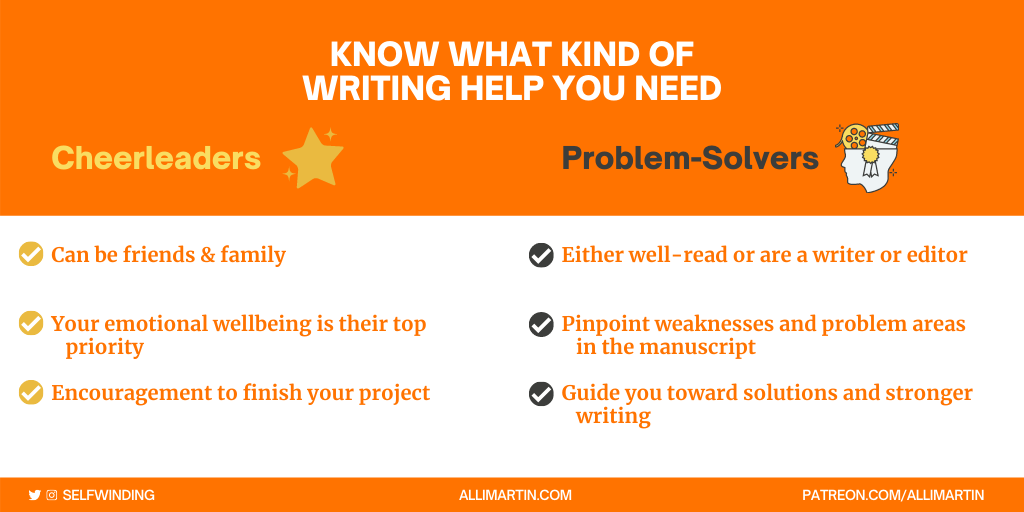
Problem-Solvers can come from your friends and family but should be familiar with your genre and are preferably either well-read or are a writer or editor. They’re going to help you pinpoint weaknesses and problem areas and, hopefully, guide you toward solutions and stronger writing. (Solution guidance is sometimes, “Have you tried X? Y? Z? AA? Etc.”) Problem-solvers are helpful when you’re stuck in a revision quagmire and can’t figure a way out (or can’t decide if the revision does the thing you need it to do). Their feedback can help you make a list of issues to address in your next revision or identify ways to polish up a nearly there piece. You can hire a problem-solver (hello), but if you’re hiring work, absolutely have a complete draft of your manuscript—you’ll get much better, more comprehensive feedback if the editor can see the whole forest.
Whether you’re looking for actionable feedback or for support, know what you need and what to ask for. I didn’t get Problem-Solver help on my end of chapter conundrum, but the Cheerleading I received encouraged me to move on and not waste time agonizing since I had another chapter to revise. The time away from the chapter allowed me to figure out what was wrong, and when I went back for a final revision—hooray! The chapter now wraps up and carries forward. So while thinking about where to get advice, never forget that the best adviser you have for your writing might be yourself.
For full access to The Write Life, sign up on Patreon for $1 or more per month. You’ll also receive a personalized thank you in a future edition of The Write Life.
For the first time since I started posting The Write Life, I’m struggling with what to say. July has been a particularly difficult month. I’ve been grappling with feelings of isolation and loneliness, a decrease in creativity, and generally the suffocation of being hemmed in (which would have nothing to do with quarantine, am I right?). My focus has been drifting and I’ve had to consciously capture and cultivate it to get anything done.
Which is part of the reason I’ve been drinking a lot of tea.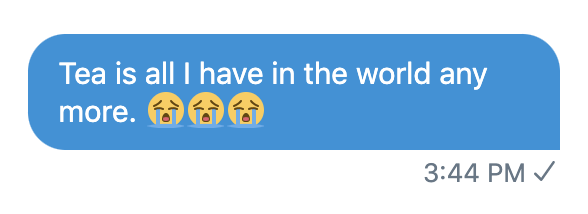
I’ve read much advice over the years about writing rituals and how to use those rituals to trigger a mental shift to a writing mindset. While my rituals have remained fairly sparse, in this troubling time, I have absolutely embraced the ritual of making tea.
Before I sit down to write, I make a cup of tea. Preparing it occupies my hands, and then I have a few minutes to think while it steeps. I’ve been using that time to start planning what I’m going to write. I daydream what comes next, play with dialogue exchanges, or noddle over where to fit in some description. (Sometimes I have to grab my phone to capture something, which means, hey, I already started writing!) As preparation goes, it’s been a huge help in focusing my thoughts so I’m ready to write by the time I sit down in front of the computer.*
To deepen this idea of ritual—of linking making tea to preparing to write—I’ve also started reserving teas to drink only (or at least primarily) when I’m writing certain things.
- When writing steampunk? Of course, that means it’s time to drink Harney & Sons Victorian London Fog.
- To balance out dark, angsty writing, I go for the soft citrusy taste found in the Luther Hargreeves fandom blend from Adagio.
- When I’m writing something light and carefree, or more comedic, I snuggle up with the Bucky Barnes fandom blend from Adagio. (Which I keep saying tastes like pre-war coziness, pal-ing around New York City with Steve Rogers.)
- I’ve even got a go-to tea for editorial work, specifically Adagio’s Chocolate Chip. Oh yeah, this tea making thing has extended beyond writing rituals and has become essential for any kind of focused work.
Am I still struggling with isolation, loneliness, and all those other things? Heck yeah. But at least I have tea and I can cling to this small joy while still forcing myself to get some work done.
*Most days. Some days there’s still a struggle and I have to utilize one of my other focusing activities.
For full access to The Write Life, sign up on Patreon for $1 or more per month. You’ll also receive a personalized thank you in a future edition of The Write Life.
In June I took a break from my Writers Five goals so I could concentrate on getting organized.
I recently started using Trello to organize and track freelance editorial projects. And, after having success with that, I decided Trello might be just what I need to organize my writing life. I’ve had a bad habit of amassing ideas I don’t work on, or getting caught up in a detail and abandoning a project for a long time, or coming back to an idea and spending a long time sorting out where I was and what I was doing. Keeping a list of ideas or titles hasn’t been enough. I needed a resource that would allow me to organize thoughts, record information, and remind myself about progress. So far Trello seems to be fitting the bill! (More information about how I’ve done that is available in the June Writing Resources available on my Patreon.)
Part of the reason I’ve been failing my write goal of the Writers Five is that I’ve lacked the kind of structure I now have with Trello. I’m very good at working to deadlines, but if the deadlines are loosey-goosey, I ignore them and just go wherever my attention feels like drifting. Now I have my attention focused on the projects that are Ready to Go and I can make sure I’m moving forward with purpose.
Which brings me back to the Writers Five.
I have really fallen off with keeping up with my goals during the last few months. Some of that is related to the general upheaval and uncertainty that is 2020, but some of that is related to this lack of focus. I’ve been making good progress with my reading goals, but the write, release, and research goals have been… lackluster. During June I decided to give myself a break from my goals to find a little more focus. I’m not sure I feel ready to fully embrace my goals in July, but I’m going to be more honest about what I’m working on and focus on the goals I know I can achieve.
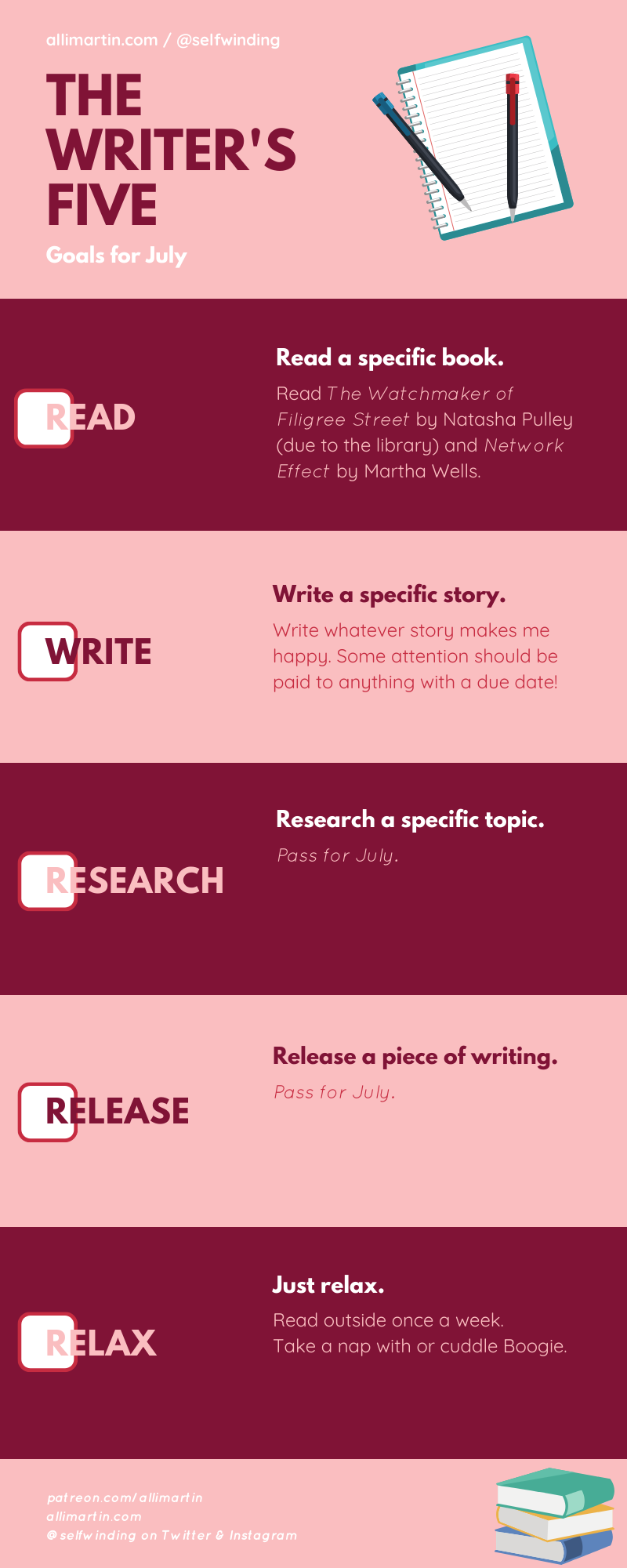 So, here are my Writers Five goals for July:
So, here are my Writers Five goals for July:
Read a specific book.
Read The Watchmaker of Filigree Street by Natasha Pulley (due to the library) and Network Effect by Martha Wells. I’ve started both, so progress will be made, even if I don’t finish them both this month.
Write a specific story.
Write whatever story makes me happy. Some attention should be paid to anything with a due date! (A lot of attention will be paid to anything with a due date, but I’m still allowed to be a bit willynilly with writing this month.)
Research a specific topic.
Pass for July.
Release a piece of writing.
Pass for July.
Just relax.
Read outside once a week. Take a nap with or cuddle Boogie.
For full access to The Write Life, sign up on Patreon for $1 or more per month. You’ll also receive a personalized thank you in a future edition of The Write Life.
One of the worst parts of quarantine for me is giving up going to conventions. I love conventions. I love being around people excited about stuff, geeking out with professional geeks, and seeing people display their obsessions in all manner of creative ways. But the convention community is creative, perseverant, and bold as all hell, so it shouldn’t have surprised me to see conventions not only move online but do so in a way that made me feel like I was actually at a con!
 In mid-May I attended Flights of Foundry, a streaming conference for sci-fi and fantasy writers. The conference was genuinely amazing, packed with great content—much more than I would have expected for a free conference—and spanning enough hours I was rooted to my computer for more or less 12 hours a day. Was I fatigued by the end? Certainly, but in the good way.
In mid-May I attended Flights of Foundry, a streaming conference for sci-fi and fantasy writers. The conference was genuinely amazing, packed with great content—much more than I would have expected for a free conference—and spanning enough hours I was rooted to my computer for more or less 12 hours a day. Was I fatigued by the end? Certainly, but in the good way.
The thing that impressed me the most about Flights of Foundry was how they recreated an in-person experience with virtual tools. The conference operated through several different panel “room” streams, which stayed open between panels. The schedule directed attendees and panelists to the different streams, the same way you might shuffle between panel rooms in a hotel. The rooms didn’t disappear when the panel was over, and if you wanted to just stay in one stream/room, another panel would start in a moment. That aspect alone was enough to make me feel more like I was visiting a conference room than a video stream.
To facilitate the conference atmosphere, Flights of Foundry had a corresponding Discord server. Each panel stream had a Discord channel where you could “attend” with everyone else. This allowed for discussion between and during panels. It allowed the audience to have secondary conversations, questions, and sharing outside of what would have been possible in the in-person format. (I pulled so many book and article recommendations from the Discord.) It was a little like the experiences I’ve had live-tweeting panels, except everyone responding to commentary had the relevant context without me having to also tweet the context.
Outside of the panel room channels, the Discord offered additional places to chat and meet people with similar interests (editor-chat, comics-creator-chat, writer-chat, for example). I didn’t play in the non-panel channels during the convention, but some of them have stayed active, even a couple weeks later.
Suffice it to say, I was extremely happy attending Flights of Foundry as a virtual conference, and if this is any indication of what the convention season might be like for the remainder of 2020, I’m not worried. I’ll miss seeing my friends’ faces in person, but many of the other aspects of conventions can be reproduced virtually, and I’m excited to continue visiting more conferences than I would in a normal year. (Travel is so much easier when I just have to walk from my bedroom to my office.)
For full access to The Write Life, sign up on Patreon for $1 or more per month. You’ll also receive a personalized thank you in a future edition of The Write Life.
The second month in quarantine slowly felt more and more normal as new routines settled into habits and new habits became familiar. Some changes, actually, are welcome and have provided more structure to my day and made me more productive. Whereas March saw my motivation and productivity slowly folding like a flan in a cupboard, April built up to impressive amounts of writing (over 25,000 words) and finally getting back to editing projects. (Which, by the way, thank you to everyone sitting static in the queue for most of the month. Your patience has been key to maintaining my mental health.)
One thing that has helped a lot is that six-days a week I run virtual write-ins for Central Florida Inklings. Inklings used to be my face-to-face writing group that met once a week, but since shifting to an online format, I started offering weekday write-ins. We’ve got a couple times that are stable, but the other times shift, allowing different members to participate and allowing me to have a little variation day to day and week to week, which is, let me tell you, something I desperately needed. Working from home—as I’m sure many of you have noticed—has a sameness that can be devastating. It’s all too easy to forget what day it is when there’s so little variation in your life or schedule. But these write-ins have made me work a little harder to remember the day of the week, and that in turn has helped me stay present and active.
 Another improvement to quarantine life is that I purchased some noise-cancelling headphones. It’s now much easier for me to get a quiet slice of time to write and edit, and I can listen to some bops whenever I like. (There may have been a marked increase in Dance Party Writing Breaks over the last two weeks.) I’m still searching out the perfect playlist for writing, but for now, being able to dull the random noises around me is working wonderfully.
Another improvement to quarantine life is that I purchased some noise-cancelling headphones. It’s now much easier for me to get a quiet slice of time to write and edit, and I can listen to some bops whenever I like. (There may have been a marked increase in Dance Party Writing Breaks over the last two weeks.) I’m still searching out the perfect playlist for writing, but for now, being able to dull the random noises around me is working wonderfully.
While many states and cities are planning to open quarantine within the next month, I’m planning to stay isolated through the end of May. As I’ve said before, quarantine life is a lot like my regular life, so staying isolated to keep my household healthy isn’t much of a burden. But, uh, I may have to venture out for tacos or to stand in a library or bookstore. (Browsing my home bookshelves is just not the same.)
For full access to The Write Life, sign up on Patreon for $1 or more per month. You’ll also receive a personalized thank you in a future edition of The Write Life.
Well, this month certainly has been a year, hasn’t it?
First, I hope wherever you are, you’re safe, have everything you need, and are scared enough to take every precaution but not so scared that you’re immobilized. Mostly, I hope you’re taking care of yourself in whatever fashion that needs to be. (Which could be taking a break from writing—we’ve all been through a trauma, so give yourself the space to deal with your own feelings before dealing with your characters’ feelings.)
For me, quarantine isn’t that different from my normal life. I already work from home and am used to socializing online. I can’t escape to write at my favorite restaurant or in the shadow of Hogwarts, and my in-person writing group has now become my other online writing group, but mostly life is the same.
I shower every day, put on a nerdy t-shirt, and write.
I spend a little more time re-watching old favorites and reading comic books and escapist fiction.
I have anxiety attacks and try to forget whatever doomsday numbers I saw in some article.
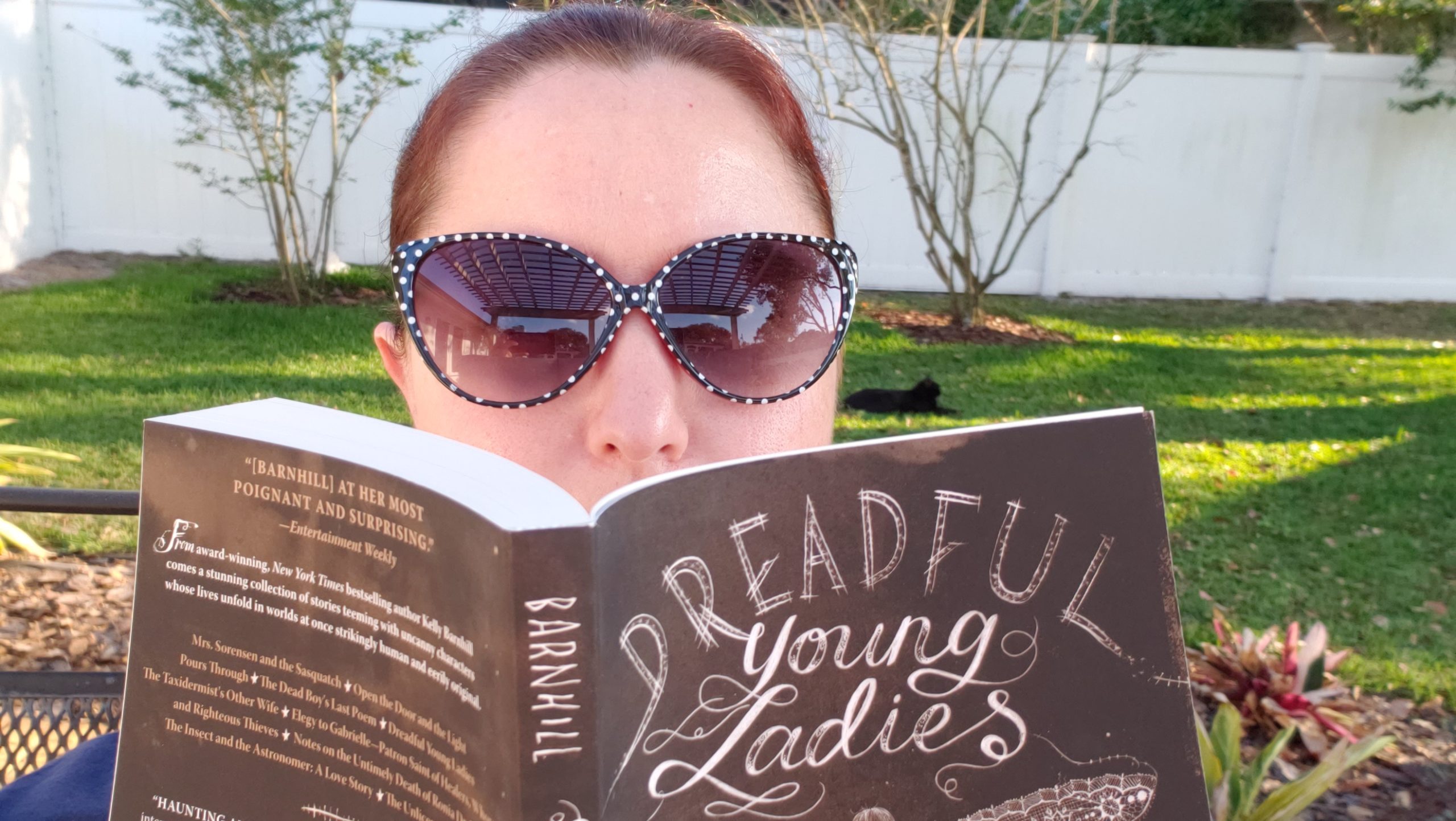 I read on the porch and take pictures of how pretty things are around me (or of the cheesecake I’m eating because that cheesecake is saving my life at the moment).
I read on the porch and take pictures of how pretty things are around me (or of the cheesecake I’m eating because that cheesecake is saving my life at the moment).
I take naps with my cat.
I try to focus enough to edit, write Patreon posts, or whatever else I’m supposed to be doing while counting how many days it’s been since my last possible virus exposure.
I have difficulty sleeping, but eventually drift off and wake from anxiety dreams.
I order tea online. (I probably have enough tea to see me through this.)
I revisit our virus protocols for quarantining or cleaning anything coming into the house and am grateful that my paranoia isn’t being treated as something negative.
I run additional sessions for my writing group because writing is the one constant in my life and right now it doesn’t have to be such a lonely profession. It shouldn’t be a lonely profession. Writing has always been one of the things connecting me to people, and now more than ever it’s the connection I need.
For full access to The Write Life, sign up on Patreon for $1 or more per month. You’ll also receive a personalized thank you in a future edition of The Write Life.
This past month I hit a landmark in my daily writing goal: 1,500 days of writing! I talked about how I started writing daily when I hit 1,000 days back in 2018, so if you want the origins of this obsessive goal, check out the post, 1,000.
While I’d like for this announcement to be filled with positivity and congratulations, that’s not entirely how I feel about it because aside from writing daily, I feel like I don’t have a lot to show for all this hard work.
Since 2016 I’ve finished a novel, revised a novel (thrice), wrote half a draft of two other books, and drafted many other short stories, though I haven’t published any original fiction. In other words, my writing life has been stagnated in the measurable areas “that count.”
Writing 1,000 days provided me with consistency and confidence. It helped shake off some of the doubt I had about my ability to start and keep writing. But writing another 500 days has brought with it different concerns and questions. Most specifically, how do I turn this productivity into published works?
That’s the question I’ve been grappling with this past month. I don’t believe there’s an easy answer—and there’s certainly not one answer—but I’ve been throwing spaghetti at the wall to see what sticks, and see what sort of drips down the wall because it’s kind of sticky but not fully cooked. (If you’re getting the idea that this has been a messy process, you would be right!)
I still don’t have any answers, but I have a list of things I’ve tried:
- I set up a new email address and emailed myself like I was a writing coach.
Sounds goofy, but I figured it was finally time to take advantage of my abilities to analyze other people’s work and my ability to disassociate when I’m speaking to or through a character. Essentially this became a more organized way of talking to myself out loud. (And it was a little more productive, because I’d already written all the ideas in the email!)
- I wrote a revision plan.
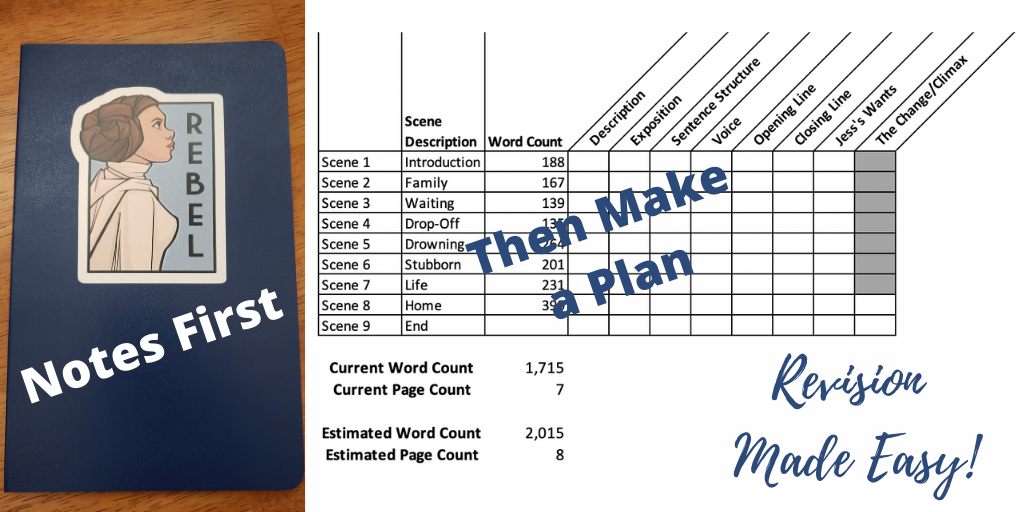 This is actually an old practice, but something I haven’t done in a while, for whatever reason. I read over a short story and instead of shuffling commas and agonizing over diction, I kept notes on what needed to change and what I needed to review. I translated that into a progress chart so I could work through each item and check it off.
This is actually an old practice, but something I haven’t done in a while, for whatever reason. I read over a short story and instead of shuffling commas and agonizing over diction, I kept notes on what needed to change and what I needed to review. I translated that into a progress chart so I could work through each item and check it off. - I tricked my resistance to specific tasks by making goals of other tasks.
I admit that I didn’t do this on purpose, but it wound up working, so it’s going on the list. When I was making my Writer’s Five goals for February, there were two projects I was considering focusing on for my write and release goals. The one I picked was a short story I felt some resistance to working on, but felt pretty comfortable about where it was. I avoided working on it by instead working on the project I felt more resistance to completing because it included revising an outline and sample chapters. But, uh, I finished the outline and am into the sample chapters. While avoiding the other task. So… yay?
Do you have any “tricks” you use to get yourself to finish writing things? Mind sharing? I need some help.
